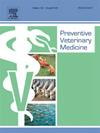Novel characterisation of dairy herds in Wales: A description of principal herd typologies and antimicrobial use patterns
IF 2.2
2区 农林科学
Q1 VETERINARY SCIENCES
引用次数: 0
Abstract
Antimicrobial resistance (AMR) is one of the top global public health concerns. Reducing and refining antimicrobial use (AMU) in farmed livestock is vital in slowing the development of AMR and preserving the efficacy of antimicrobials (AMs) in both humans and animals. Understanding the risk factors for AMU, however, is crucial to informing sustainable and effective farm AMU reduction and prudent use strategies. As a range of farm-level variables are likely to impact AMU, multidimensional exploratory analyses play a pivotal role in identifying direct and indirect factors influencing variation in AMU typically observed between dairy herds. This study used exploratory approaches to investigate whether typologies of dairy herds could be determined on the basis of farm characteristics, health parameters and management practices, and whether these herd types were differentiated by AMU. This study was conducted on 21 dairy herds in Wales, United Kingdom. Comprehensive surveys were administered and 224 usable variables regarding farm characteristics, herd health parameters and management practices were collated. AM sales data for each herd were used as a proxy for AMU. Multiple correspondence analysis (MCA) and hierarchical clustering on principal components (HCPC) were performed. The top 10 dimensions yielded by MCA explained 65.7 % of the total variance. Two data-driven typologies of dairy herds, produced from the first two cut-points of the HCPC dendrogram, were visualised and described. Here, five partitions of relatively homogeneous herds (herd types) were characterised and contrasted by 73 variable categories. Herd types were primarily constructed by variables focused on drying-off practices (and use of intramammary [IMM] AMs), herd size, stock purchasing and culling rates in addition to those concerning husbandry, disease management, grazing practices and veterinarian contact. Herd types characterised by performing blanket dry cow therapy (BDCT) used a higher mass of dry cow IMM AMs, EMA Category C and B AMs and had higher medium total AMU (mg/PCU) compared to herd types characterised by performing selective dry cow therapy (SDCT). From this study help untangle the myriad of factors influencing AMU at herd level and provide insight into the challenges of good AM stewardship. Strategies for sustainable reductions in AMU should be directed toward specific herd types identified, such as targeted interventions to implement SDCT. Multivariate exploratory approaches of dimensionality reduction and clustering are invaluable in elucidating the risk factors for AMU when utilising high-dimensional datasets. Future prospective studies are needed to validate herd types and confirm causality of findings.
威尔士奶牛群的新特征:主要牛群类型和抗菌素使用模式的描述
抗微生物药物耐药性(AMR)是全球最重要的公共卫生问题之一。减少和改进养殖牲畜中抗菌素的使用对于减缓抗菌素耐药性的发展和保持抗菌素对人类和动物的功效至关重要。然而,了解抗菌素的风险因素对于可持续和有效地减少农场抗菌素和审慎使用策略至关重要。由于一系列农场层面的变量可能影响AMU,多维探索性分析在确定影响奶牛群之间典型的AMU变化的直接和间接因素方面发挥了关键作用。本研究采用探索性方法,研究奶牛群的类型是否可以根据农场特征、健康参数和管理实践来确定,以及这些奶牛群类型是否可以通过AMU来区分。本研究在英国威尔士的21个奶牛群中进行。进行了全面调查,整理了有关农场特征、畜群健康参数和管理做法的224个可用变量。每个牧群的AM销售数据被用作AMU的代理。进行了多重对应分析(MCA)和主成分层次聚类(HCPC)。MCA产生的前10个维度解释了总方差的65.7% %。从HCPC树形图的前两个切点产生的两种数据驱动的奶牛群类型被可视化和描述。在这里,5个相对同质的群体(群体类型)被划分为特征,并通过73个变量类别进行对比。畜群类型主要由以下变量构成:除有关畜牧业、疾病管理、放牧做法和兽医接触的变量外,还包括干燥做法(和乳内[IMM] AMs的使用)、畜群规模、牲畜购买和扑杀率。与采用选择性干牛治疗(SDCT)的牛群相比,采用毯式干牛治疗(BDCT)的牛群使用了更高质量的干牛IMM AMs, EMA C类和B类AMs,并且具有更高的中总AMU (mg/PCU)。这项研究有助于理清影响牧群水平AMU的无数因素,并提供对良好AM管理挑战的见解。可持续减少AMU的战略应针对确定的特定种群类型,例如实施SDCT的有针对性的干预措施。当利用高维数据集时,多维降维和聚类的探索方法在阐明AMU的风险因素方面是无价的。未来的前瞻性研究需要验证群体类型和确认因果关系的发现。
本文章由计算机程序翻译,如有差异,请以英文原文为准。
求助全文
约1分钟内获得全文
求助全文
来源期刊

Preventive veterinary medicine
农林科学-兽医学
CiteScore
5.60
自引率
7.70%
发文量
184
审稿时长
3 months
期刊介绍:
Preventive Veterinary Medicine is one of the leading international resources for scientific reports on animal health programs and preventive veterinary medicine. The journal follows the guidelines for standardizing and strengthening the reporting of biomedical research which are available from the CONSORT, MOOSE, PRISMA, REFLECT, STARD, and STROBE statements. The journal focuses on:
Epidemiology of health events relevant to domestic and wild animals;
Economic impacts of epidemic and endemic animal and zoonotic diseases;
Latest methods and approaches in veterinary epidemiology;
Disease and infection control or eradication measures;
The "One Health" concept and the relationships between veterinary medicine, human health, animal-production systems, and the environment;
Development of new techniques in surveillance systems and diagnosis;
Evaluation and control of diseases in animal populations.
 求助内容:
求助内容: 应助结果提醒方式:
应助结果提醒方式:


